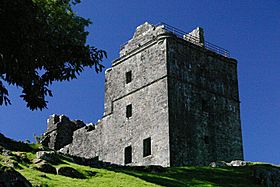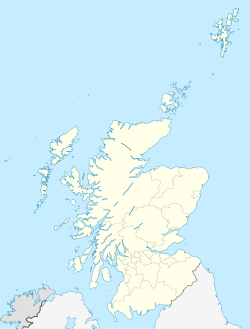Carnasserie Castle facts for kids
Quick facts for kids Carnasserie Castle |
|
|---|---|
| Kilmartin, Scotland | |
 |
|
| Coordinates | 56°09′05″N 5°28′51″W / 56.1515°N 5.4809°W |
| Site information | |
| Open to the public |
Yes |
| Condition | Partially ruined |
Carnasserie Castle (sometimes called Carnassarie) is a cool old castle from the 1500s. It's a "tower house," which means it's a tall, strong building. People notice its unique design and fancy Renaissance style. You can find it about 2 kilometers (1.25 miles) north of Kilmartin in western Scotland. It's in an area called Argyll and Bute.
Contents
Exploring Carnasserie Castle's Past
Who Built Carnasserie Castle?
Carnasserie Castle was built by a church leader named John Carswell. He was a "reforming churchman," meaning he wanted to change the church. John Carswell was in charge of the church in Kilmartin. He also worked for the King at Stirling Castle. Later, he became a "titular Bishop of the Isles." This meant he had the title of bishop, but maybe not all the power.
Carswell did something very important for Scotland. He published the first book ever printed in Scottish Gaelic. This book was a translation of a famous religious text. Building the castle started in 1565. Workers came from Stirling to help build it. Even though it seemed like he was building it for his boss, the Earl of Argyll, Carswell actually wanted it for himself.
What Happened to the Castle?
When John Carswell passed away in 1572, the castle went to the Earl of Argyll. In 1643, it was sold to Donald Campbell of Auchinleck. Later, another Duncan Campbell owned it. He was one of the few people who supported a rebellion in 1685. This rebellion was against King James VII.
After the rebellion failed, a group called the Atholl Raid attacked the area. They caused a lot of damage in Argyllshire. Even though Duncan Campbell got his lands back in 1689, he was in a lot of debt. In 1690, he told the government that Maclean clansmen had burned Carnasserie Castle. He also said they stole 2,000 cattle and killed his uncle.
The outside walls of the castle are still mostly standing. But Carnasserie was never rebuilt after that attack. The Auchinbreck family eventually ran out of money. In the 1800s, the castle and its land were sold. They were bought by the Malcolms of Poltalloch family. They also own another nearby castle called Duntrune Castle.
Today, Carnasserie Castle is a protected historic site. It is looked after by Historic Environment Scotland. You can visit the castle and explore its ruins.
Discovering Carnasserie Castle's Design
How Was the Castle Built?
Carnasserie Castle has not been changed much since the late 1600s. This means it shows us exactly what 16th-century buildings looked like. The castle is on high ground near an important path. But it was built more for living in than for fighting.
The castle has two main parts. There's a tall, five-story tower house. There's also a longer, three-story hall house. Together, they offered many rooms for people to live in.
What Can You See Inside?
In the basement, you can still see parts of the storage rooms and a kitchen. The kitchen had a very large fireplace and a place for water. Above the basement is the main hall. This hall connects to a large drawing room in the tower house. The drawing room still has its stone floor and a big fireplace. This fireplace has beautiful stone carvings.
A wide staircase goes from the entrance up to the hall. This staircase is inside a small tower. Another smaller staircase goes from the hall up to the top of the tower. This leads to a walking path around the top, called a parapet walk. The rooms on the upper floors would have been bedrooms.
Special Features of the Castle
On the outside, you can see many "double keyhole" gunloops. These were small openings for guns. There are also decorative stone lines and supports. Above the entrance, there are blank stone panels with carvings. You can also see the coat of arms of the 5th Earl of Argyll. It has a Gaelic saying: "DIA LE UA NDUIBHNE." This means "God be with O'Duine." It refers to the ancient ancestors of Clan Campbell.
At the very top of the tower, you can see parts of the open rounds. These were circular walkways along the parapet. There's also a small building above the stair, called a cap-house. Pieces of carved drain spouts have been found too. You can see them on display in the cellars.
To the south and west of the castle, there is a partially walled garden. An archway in the garden has an inscription: SDC LHL 1681. This stands for Sir Duncan Campbell, 4th Baronet, and Lady Henrietta Lindsay. Their support for the rebellion led to the castle's damage.
Images for kids
See also
 In Spanish: Castillo de Carnasserie para niños
In Spanish: Castillo de Carnasserie para niños



